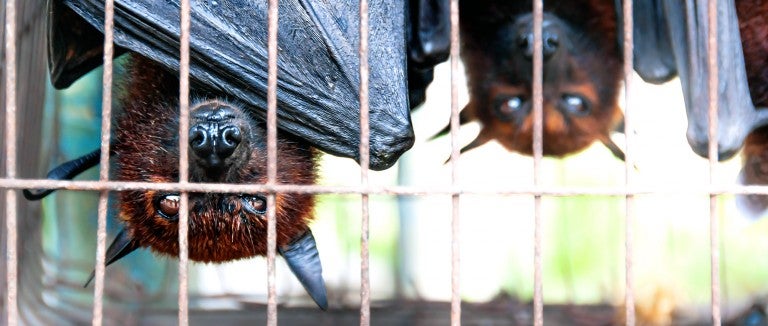In March, as people struggled to understand how the precursor of the virus that causes COVID-19 emerged from horseshoe bats in southern China and reached humans in the central city of Wuhan, Humane Society International policy specialist Peter Li fielded one question again and again: “Why do Chinese people eat bats?”
Most people in China do not eat bats, but the myth exploded on Fox News and other media outlets. It didn’t help that a Chinese influencer had traveled to Palau, Micronesia, in 2016 to eat exotic food and posted a video of herself eating a fruit bat. For days, Li was forced to repeatedly explain that the virus did not jump to humans because people consumed virus-infected bats—that in fact bats were not known to have been sold in the wildlife market tied to many of the earliest cases. Instead, it was the wildlife trade that brought a bat virus to a city of 11 million people.
This spring, the Humane Society of United States and HSI joined with more than 240 other groups to call for a ban on wildlife markets and an end to the commercial wildlife trade around the globe. In February, China issued a temporary ban on the trade and consumption of wildlife for food. But even as officials from the World Health Organization, the United Nations Convention on Biological Diversity, and the U.S., as well as members of Congress, urge an end to the wildlife trade and markets, others argue that’s neither necessary nor possible. Here are the facts.
MYTH: We have no idea if the virus that causes COVID-19 started in the Wuhan wildlife market or is tied to the wildlife trade.
REALITY: The strongest evidence of the virus’s origin points to a section of the Huanan open-air market where more than 75 species of stressed wildlife were stacked in wire cages and slaughtered on-site for buyers. “You almost couldn’t design a more perfect setting for the transmission of disease,” says Teresa Telecky, HSI vice president for wildlife. “Animals are crowded together and you have all these fluids—blood, saliva, feces.” After the government closed the market, tests revealed the virus in the wildlife section. Two-thirds of the 41 earliest identified cases had direct ties to that part of the market. Most of the rest had indirect ties (for example, a woman married to a man who worked there). Scientists are searching for the “intermediate host” mammal that carried the virus from bats to Wuhan. In 2002, the SARS (Severe Acute Respiratory Syndrome) epidemic began when civets infected with a closely related bat coronavirus brought it to a wildlife market in South China.
MYTH: Wildlife markets across China reopened soon after the government “ban,” so such closures don’t work.
REALITY: So-called “wet” markets that sell farm animals (dogs and cats in South and Southwest China) have reopened, but the sections of open-air markets that sell wildlife remain closed. The cities of Beijing, Shenzhen and Zhuhai have shut them down permanently. In May, Wuhan banned the eating of wildlife. Beijing followed in June with a ban of its own.
MYTH: The wildlife trade is the only way some people can earn a living and is deeply rooted in traditional culture.
REALITY: In China, the wildlife trade was non-existent until the 1980s, when the Chinese government encouraged people living in poverty to start their own businesses including raising wild animals. Even after three decades of government-sanctioned growth, the wildlife food industry still represents just 0.17% of China’s GDP and less than 1% of China’s labor force of 900 million. The majority of Chinese people do not eat wildlife—in an HSI survey of 212 households across China, none reported having wildlife in their refrigerators, Li says. “I have never seen people in China protest, saying ‘We demand to eat this.’ ” Instead, most of the of farmed and wild caught wildlife goes to expensive restaurants frequented by business people. The Chinese government is buying out wildlife farmers in the Hunan, Jiangxi and other provinces so they will raise alternatives such as mushrooms and medicinal herbs.
MYTH: If the wildlife trade is banned, it will just go underground, so it’s better to allow it and regulate it more strictly.
REALITY: It is very hard to enforce the 20 different rules governing the legal wildlife trade in China, which is already used as a front for smuggling threatened and endangered species, and easier to enforce a total ban, says Li. “It is more costly to ensure compliance than to go after lawbreakers.” China’s regulatory resources are barely enough to oversee the non-wildlife food industries such as livestock that serve most of the country’s consumers.
MYTH: The wildlife trade is only a problem in China.
REALITY: The wildlife trade and animal-related disease outbreaks extend around the globe. Ebola has repeatedly jumped from bats to primates and humans in Central and West Africa. Middle East Respiratory Syndrome (MERS) jumped from bats to camels to humans in Saudi Arabia. In the U.S., the Centers for Disease Control and Prevention has responded to an Ebola outbreak in imported macaques at a primate research center in Virginia and monkeypox that spread from rodents imported from Ghana to pet prairie dogs and then people. “The pandemic is not culture-specific or ethnicity-specific,” says Li. “It was caused by a particular mode of production in which large numbers of animals of different species are put in close proximity to each other. With the right recombination of viruses, pandemics could happen anywhere.”
Want more content like this?
This was written and produced by the team behind All Animals, our award-winning magazine. Each issue is packed with inspiring stories about how we are changing the world for animals together.
Learn MoreSubscribe
